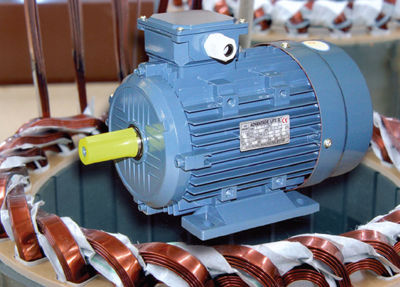By conducting an audit of all the motors used in a plant, noting their nameplate information, details of the application requirements and how important they are to production, spare units can be purchased, quickest/cheapest suppliers can be noted and all the information needed to ensure a reliable repair is immediately at hand.
Why Do Motors Fail?
Both the condition monitoring and plant audit should give clues to why a unit has failed, or is failing. Condition monitoring surveys can include electrical, thermal, noise, vibration and oil analysis, which can identify contaminated windings, failing insulation, bearings and lubrication to give engineers vital information as to the efficiency of the unit, as well as the cost and timescale of repairs. The equipment survey, on the other hand, provides information that allows engineers to assess the suitability of the motor for its application. For example, a motor may be burning out because of an insufficient power rating, or due to changes in the driven load or gearing as more power or torque output is required.
Environmental factors should also be taken into account, such as increased moisture levels or ambient operating temperatures, and the repair history of the motors can be used for working out the life expectancy of the unit after repair. Bearings are responsible for over half of all motor failures, and it is usually the result of poor maintenance practices such as overloading, using incorrect or excessive amounts of grease for the application, or lack of cleaning.
Replacement Options
To keep downtime to a minimum, standard motors should ideally be kept in stock on site, but it is becoming more common for larger companies to have consignment stocks left on site by a contracted supplier to avoid the investment costs involved. If holding stock is not economical to the provider, or motor tasks are more specialized at a site, making an assessment of the potential suppliers with cost comparisons will also save time and money when the need arises.
When repairing a motor, having a good idea of what repair services are offered by a company and the respective costs of each level of repair can also be beneficial to avoid unexpected costs, i.e., the difference between basic reconditioning, re-insulating, stator rewinding, stator repair, major lamination repair or a new shaft.

Repair or Replace?
It is a general rule that standard motors of 11 kW or less should be replaced, as they are generally stock items available at short notice and are not cost-effective to repair; however, testing/dismantling to find the cause of failure is recommended. Depending on the severity of the failure mode, motors of 11 kW and above can be worth repairing. If the unit proves economic to repair, that repair can be completed quickly to take advantage of a shutdown period or returned to site as replacement stock.
In an emergency breakdown situation, though, the opportunity cost of waiting for an analysis nearly always outweighs the money saved through repair. Standard replacement units in the 11–250 kW range are usually available in less than 48 hours, so these can be a viable option. Exceptions to the 11–250 kW range include servomotors used for high-precision automation positioning systems, and motors designed for specialist power transmission applications. EFF1 high-efficiency and ATEX explosive atmosphere motors can also prove to be exceptions, as their complex designs make for expensive replacement, but also for more costly repairs. Additionally, standard motors that only require an electrical or mechanical overhaul can also be quicker and more cost effective to repair than purchasing a replacement.
Standard motors of 250 kW and above are more likely to be repaired, due to the longer lead times for larger motors. Exceptions to this rule are when failure is catastrophic; i.e., where bearing mounts, frames, stator cores or shafts need replacing. But even if this is the case, over the long term it is often worth repairing the unit and keeping it as a backup. Some companies can repair motors more quickly depending on the urgency of the job and nature of the failure; however, extra costs may be incurred, putting further emphasis on the need to plan ahead.
A survey should take into account previous repairs, enabling engineers to find out if the damage is isolated to the same area and whether the repair was to the correct standard or if the unit is again unsuitable for the application. If the damage is limited to these areas, and the previous job proved cost-effective, it is usually worth repairing the unit for a second time, but repairing additional damage may result in diminishing returns.






